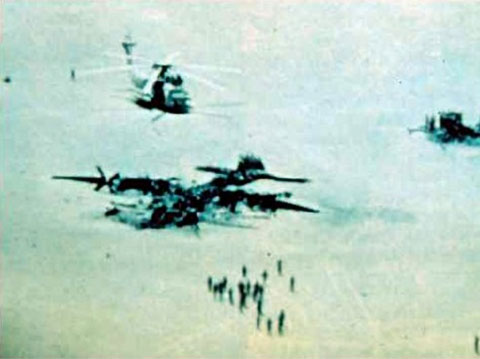
  
  
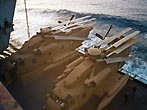  
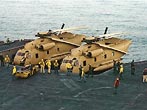  
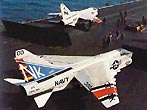  
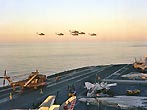  
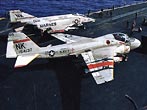  
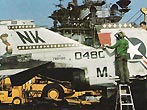  
  
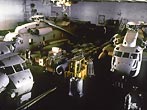  
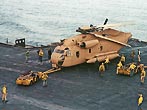  
  
  
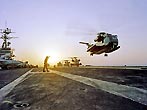  
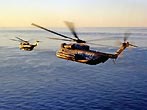  
  
  
  
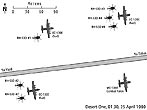  
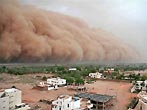  
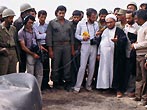  
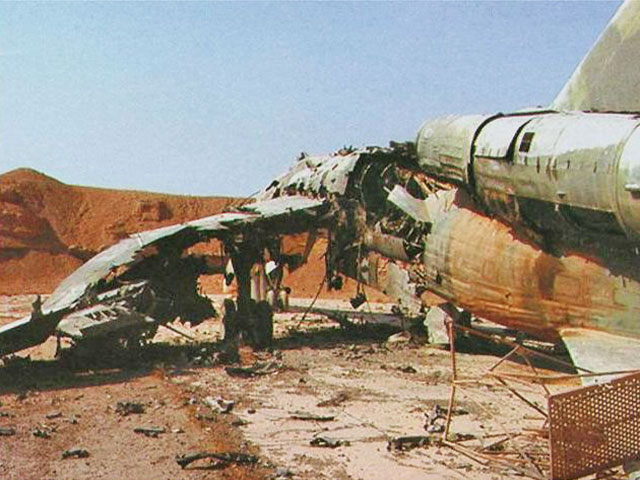  
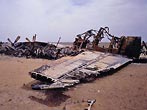  
  
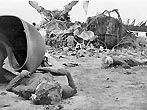  
  
  
  
|
 |
24-25 April 1980 - Operation Eagle Claw or Evening Light: The Iran Hostage Rescue Mission
Operation Eagle Claw (or Operation Evening Light or Operation Rice Bowl) was an American military operation ordered by U.S. President Jimmy Carter to attempt to end the Iran hostage crisis by rescuing 52 Americans held captive at the U.S. Embassy in Tehran on 24 April 1980. Its failure, and the humiliating public debacle that ensued, damaged American prestige worldwide. Carter and many experts concluded that the failure to free the hostages played a major role in Reagan's victory in the 1980 U.S. presidential election.
The operation encountered many obstacles and was eventually aborted. Eight helicopters were sent to the first staging area, Desert One, but only five arrived in operational condition. One encountered hydraulic problems, another got caught in a cloud of very fine sand, and the last one showed signs of a cracked rotor blade. During planning it was decided that the mission would be aborted if fewer than six helicopters remained, despite only four being absolutely necessary. The commanders asked President Carter for permission to abort. In a move that is still discussed in military circles, Carter granted the request.
As the U.S. force prepared to leave, one of the helicopters crashed into a transport aircraft which contained both servicemen and jet fuel. The resulting fire destroyed both aircraft and killed eight servicemen. Operation Eagle Claw was one of Delta Force's first missions.
On 4 November 1979, after a popular revolution swept the Shah of Iran, a close American ally, out of power, Iranian students backing the new revolutionary Islamic government stormed the US embassy in Teheran and took the staff and USMC security contigent hostage. In all, 52 Americans were captured and it was unclear whether they were being tortured or readied for execution. After six months of failed negotiation, the US broke diplomatic relations with Iran on 8 April 1980 and the newly certified US Army Special Forces Operational Detachment-Delta (Airborne) was put on full alert and plans were being drawn up for a rescue.
The Americans faced a daunting task. Teheran is well inside Iran and away from friendly countries. The hostages were not held at an airport as in Israel's four years earlier Entebbe raid. Good intelligence was hard to come by about forces inside the embassy and in Teheran. And of course, all the planning and training had to be carried out in complete secrecy.
Background
In the late 1970s, the regime of the Shah of Iran, long a regional bulwark against the USSR, lost favor with the Iranian people and was overturned by an Islamic theocracy under the leadership of the Ayatollah Ruhollah Khomeini. The Shah left the country and was finally allowed to enter the United States for cancer treatment by President Jimmie Carter. Demanding the Shah’s return, the Iranian revolutionary government seized the US Embassy compound in Tehran on 4 November 1979, taking American diplomatic personnel hostage. After selective release of some prisoners, the number of Americans finally being held amounted to some 53 on the Embassy grounds, and a further three, including US Chargé d'Affaires, Bruce Laingen, at the Iranian Foreign Ministry.
President Carter sought a diplomatic solution, but Khomeini would have none of it. He preferred to use the hostage issue as an embarrassment to the Carter administration, which it indeed remained until Carter’s last day in office. As a secondary solution, the President approved planning for a military option, on the proviso that it be kept secret. At the time there was no joint special operations command to take up the mission, leaving Secretary of Defense Harold Brown and Chairman of the Joint Chiefs David Jones little option but to stand up an ad hoc planning cell from within the Joint Staff’s J-3 Special Operations Division. This was done and on 12 November the operational planning group was dubbed Rice Bowl.
Major General James B. Vaught (US Army) was appointed Joint Task Force commander, and a team of officers was assembled to lead the various components, including: Colonel Charles A. Beckwith (founder of the Army’s new Delta Force counter-terrorist group) to be the ground assault commander; Colonel James H. Kyle (long-time USAF MC-130 special operator) to command the fixed wing contingent; and Marine Lieutenant Colonel Edward Seiffert (an experienced night-vision flyer) to lead the helicopter force. From the beginning the idea that all the services should have a “piece of the action” plagued the operation and led to bad decisions. This was the first major mistake.
The Planning
In the realm of military planning there are plans that might work and plans that won’t work. In the cold light of history it is evident that the plan for Eagle Claw was in the second category, but since the planning process was deliberately kept compartmented and secretive, no outside group could review the finished plan for a “reality check.” This was the second major mistake.
Initially, the preferred solution was the infiltration of the force by trucks from Turkish territory but this plan was rejected due political disadvantages and the risk of a great number of casualties made to discard the possibility of a night paratroopers assault so the choice fell again, after all, on the use of helicopters. By December 1979, a rescue force was selected and a training program was under way. Training exercises were conducted through March 1980 and the Join Chiefs of Staff (JCS) approved mission execution on 16 April 1980. Between 19 and 23 April, the forces deployed to Southwest Asia.
What was ultimately decided on was an audacious plan involving all four US armed forces services, 8 helicopters (Navy RH-53D's with USMC crews), 12 USAF planes ( 4 special ops MC-130E Combat Talon, 3 command post EC-130E Commando Solo, 3 gunships AC-130 Spectre, and 2 cargo C-141 Starlifter ), and numerous operators infiltrated into Teheran ahead of the actual assault. Aircraft carriers USS Nimitz (CVN68) and USS Coral Sea (CV43) were already in the Arabian Sea to provide air support if necessary with their F-14A Tomcat, A-6E Intruder and A-7E Corsair.
The basic plan was to infiltrate the operators into the country the night before the assault and get them to Teheran, and after the assault, bring them home.
The concept seemed straight forward enough: from the Persian Gulf penetrate to the capital of Iran through a variety of air and ground means; secure the hostages; and exit Iran through another variety of air means. The devil is in the details however, and to say that the plan for accomplishing Eagle Claw was overly complex would be an understatement. It would require the proverbial seven simultaneous miracles for Eagle Claw to work. The only way this can be brought home to the reader with sufficient magnitude is to provide a thumbnail outline of the way the plan was supposed to work:
The first night, three MC-130's Combat Talon were to fly to an barren spot in Iran and offload the Delta force men, Combat Controllers, and translators/truck drivers. Three EC-130's following the Combat Talon's would then land and prepare to refuel the Marine RH-53's flying in from the carrier USS Nimitz. Once the helicopters were refuled, they would fly the task force to a spot near the outskirts of Teheran and meet up with agents already in-country who would lead the operators to a safe house to await the assault the next night. The helicopters would fly to another site in-country and hide until called by the Delta operators. On the second night, the MC-130's and EC-130's would again fly into the country, this time with 100 US Army Rangers troops, and head for Manzariyeh Airfield. The Rangers were to assault the field and hold it so that the two C-141's could land to ferry the hostages back home. The three AC-130's would be used to provide cover for the rangers at Manzariyeh, support Delta's assault, and to supress any attempts at action by the Iranian Air Force from nearby Mehrabad Airbase. Delta would assault the embassy and free the hostages, then rendevous with the helicopters in a nearby football stadium. They and the hostages would be flown to Manzariyeh Airfield and the waiting C-141's and then flown out of the country. All the aircraft but the eight helicopters would be flown back, the helicopters would be destroyed before leaving.
1. First night: USS Coral Sea decoys Soviet “trawlers” away from USS Nimitz (carrying eight RH-53D Navy minesweeping helicopters to be used for the mission). Mistake: RH-53Ds were used because of operational security (they looked “right” on a carrier), in spite of having a bad operational readiness rating and no in-flight refueling capability. USAF HH-3E special operations helicopters would have been a better choice, with steps taken to disguise their appearance.
2. Three USAF MC-130E Combat Talons take off from Masirah Island (Oman) carrying the Delta Force, accompanied by three EC-130E aircraft (usually a command & control platform) which carry fuel bladders to refuel the helicopters at a rendezvous called Desert One. Mistake: Desert One would not have been necessary if USAF helicopters had been used and provisions made for in-flight refueling.
The Helicopters
3. One MC-130E lands at Desert One (pre-surveyed by the CIA) and sets up navigation aids for the remaining force. Radio silence is maintained. Mistake: inadequate provision for tactical communications would prove a hindrance during the operation.
4. Remaining fixed wing aircraft arrive and drop off Delta Force. EC-130Es remain to refuel helicopters. Mistake: timing for ground rendezvous was very tight, and could not be met by participants. Possibility of having to continue in daylight.
5. Fixed wing aircraft depart Desert One for Masirah, where MC-130E crews board other aircraft for transport to Wadi Kena, Egypt. There they ready themselves for the second night when they are to transport an Army Ranger force to secure Manzariyeh airfield, Iran, where hostages will be extracted by C-141s. An interesting problem in overtaxing aircrews.
6. Helicopters depart Desert One and drop off Delta Force at a hide site 50 miles southeast of Tehran and then proceed to their own hide site elsewhere. More possibilities to compromise the operation.
7. Delta Force meets with in-country agents providing trucks for overland movement to Tehran on night two.
8. Night two begins with Delta Force driving to a Tehran warehouse in six trucks to stage for the assault.
9. Delta Force moves to the Embassy compound (while a Special Forces team goes to the Foreign Ministry) and has 45 minutes to extract the hostages. Incomplete intelligence makes the extraction process hit-or-miss.
10. Hostages and escorts move a couple of hundred yards to a soccer stadium to meet with the helicopters for lift to Manzariyeh airfield, while being covered by an Air Force AC-130 gunship. The possibility of Iranians gaining a position to hinder the helicopter extraction is an ever-present problem.
11. MC-130Es deliver Rangers to Manzariyeh airfield to hold it and prepare for arrival of C-141s (from Saudi Arabia), and hostages in helicopters from Tehran. Other AC-130s provide covering fire.
12. Hostages arrive at Manzariyeh airfield by helicopter and depart in C-141s with Delta Force. Helicopters are destroyed in place. Provision for helicopter destruction not well thought out, and didn’t work in operation execution.
13. Carrier-based fighters provide suppression of any Iranian Air Force activity during the extraction process.
14. Air-to-air refueling provided as needed on return trip.
Finer pieces of coordination have been left out of the above outline, as well as the multiplicity of backup options which still did not cover many single point failure issues. The main theme here is that there was a lot that could go wrong. In the event, the things which did cause the mission to abort were probably merciful compared to the greater catastrophe which might have taken place if the scenario had progressed further than the Desert One rendezvous.
The Helicopters
The RH-53D ( Sikorsky S-65 ) was the specialized mine countermeasures variant ( fitted with devices for the detection, sweeping and neutralization of all types of mines ) of the CH-53 Sea Stallion . The US Navy received the first of 30 RH-53D in May 1973 to replace the old RH-3A Sea Kings and, coincidentally, the only other customer of the RH-53D was the Iranian Navy with 6 aircraft delivered to the Shah.
The determination of the type of helicopter to be used was very difficult but the Sea Stallion was selected in good part due to its great capacity to carry heavy loads. Completely supplied can take 30 people and with less fuel 50 with a maximum gross weight of 42,000 pounds (15 Tn aprox) and is capable of speeds up 160 knots. In spite of it's huge size, the Sea Stallion has been known to make a few loops from time to time.
The RH-53D variant had extra fuel tanks on the landing gear pylons so this aircraft was preferable to the normal CH-53D due it's long range. A year before, on April 1979 a RH-53D from US Navy squadron HM-12 set a new nonstop transcontinental flight by flying from Norfolk, Virginia, to San Diego, California. The helicopter flew 2,077-nm in 18.5 hours, air refueling from an Air National Guard HC-130 Hercules. The flight demonstrated the long-range, quick-response capability of the RH-53D helicopter and was commanded by Lieutenant Rodney M. Davis.
But moreover a hunting-mines helicopter would not seem outside of place on board an aircraft carrier.
In October 1979, US Navy Squadron HM-16 was participating in Canous Marcot 79, a joint U.S. - Canadian exercise, shore based at CFB Shearwater, Nova Scotia, Canada. The squadron's prime objective was to clear a simulated minefield blocking this major strategic Canadian port. Four days after returning from this Canadian deployment, HM-16 was tasked to execute a no-notice rapid deployment to the Indian Ocean area. Within a 34 hour period, all personnel and squadron assets were deployed from the commands home base in Norfolk, Virginia and stationed aboard carrier USS Nimitz where their RH-53's were painted brown for the camoflauge effect of the Iranian desert and to be similar to Iranian aircraft paint schemes.
HM-16 provided the eight helicopters for Eagle Claw and was until 19 May 1980 when the squadron returned to Norfolk after an unprecedented 193 days continuous at sea.
Go
On the evening of 24 April 1980, six C-130s left Masirah Island, Oman, and eight RH-53D helicopters departed the USS Nimitz in the Arabian Sea. Both formations headed for the location code-named Desert One.
First Problems
A month before the assault a CIA Twin Otter had flown to Desert One. A USAF Combat Controller had rode around the landing area on a light dirt bike and planted landing lights to help guide the force in. That insertion went well, with no contact, and the pilots reported that their sensors had picked up some radar signals at 3,000 feet but nothing below that.
Despite these findings, the helicopter pilots were told to fly at or below 200 feet to avoid radar. This limitation caused them to run into a haboob, or dust storm, that they could not fly over without breaking the 200 foot limit. Two helicopters lost sight of the task force and landed, out of action. Another had landed earlier when a warning light had come on. Their crew had been picked up but the aircraft that had stopped to retrieve them was now 20 minutes behind the rest of the formation.
Battling dust storms and heavy winds, the RH-53's continued to make their way to Desert One. After recieving word that the EC-130's and fuel had arrived, the two aircraft that had landed earlier started up again and resumed their flight to the rendevous. But then another helicopter had a malfunction and the pilot and Marine commander decided to turn back, halfway to the site. The task force was down to six helicopters, the bare minimum needed to pull off the rescue.
The first group of three helicopters arrived at Desert One an hour late, with the rest appearing 15 minutes later. The rescue attempt was dealt it's final blow when it was learned that one of the aircraft had lost its primary hydralic system and was unsafe to use fully loaded for the assault. Only five aircraft were servicable and six needed, so the mission was aborted.
And there were other problems. A bus came by on a dirt road shortly after the lead C-130 landed. Its driver and about 40 passengers were held until the Americans left.
Disaster
With the mission already aborted, things got worse when one of the helicopters moved to another position and drifted into one of the parked EC-130's. In the pilot's defense, it was dark and his rotors kicked up an immense dust cloud, making it difficult to see but immediately both the C-130 and RH-53 burst into flames, lighting up the dark desert night, and 8 crewmembers lost their lives.
Capt. Harold L. Lewis Jr. - USAF EC-130E A/C Commander
Capt. Lyn D. McIntosh - USAF EC-130E Pilot
Capt. Richard L. Bakke - USAF EC-130E Navigator
Capt. Charles McMillian - USAF EC-130E Navigator
Tsgt. Joel C. Mayo - USAF EC-130E Flight Engineer
SSgt. Dewey Johnson - USMC RH-53D Crewmember
Sgt . John D. Harvey - USMC RH-53D Crewmember
Cpl. George N. Holmes - USMC RH-53D Crewmember
The C-130 was evacuated and the order came to blow the aircraft and exfiltrate the country. However, in the dust and confusion the order never reached the people who would blow the aircraft. There were wounded and dying men to be taken care of and the aircraft had to be moved to avoid having the burning debris start another fire. Because of this failure to destroy the helicopters, the Americans left behind them 5 RH-53D intact and top secret plans fell into the hands of the Iranians the next day and the agents waiting in-country to help the Delta operators were almost captured.
"A few days ago the President made a very courageous decision as he ordered us to execute the rescue operation as we tried to free our Americans held hostage in Teheran. It was not a risk-free operation-there is no such thing as a risk-free operation..... we all shared considerable disappointment that we were not successful. But let's not be despondent about that. Our job is now to remain alert, to look for those opportunities, times when we can bring our Americans out. Our job is to stay ready."
Admiral Thomas B. Hayward, Chief of Naval Operations, in a video message to USS Nimitz, USS Texas and USS California during their transit home from the Indian Ocean.
After Eagle Claw a long negotiation follows, including the beginning of the Iraq-Iran war. Was on 19 January 1981 when Secretary Christopher signs the accord at 3:35 E.S.T. and on January 20, after last-minute delays over fund transfers, the hostages leave Teheran on the 444th day of their captivity, minutes after President Carter leaves office. On January 21, citizen Carter greets the hostages at Weisbaden, West Germany.
Operation Honey Badger which was to be the second attempt to rescue the hostages from Iran was no longer necessary.
Aftermath
After the failure of Eagle Claw, another even larger and more ambitious rescue planning effort was started, but it would go nowhere. The Iranian hostages and Desert One would continue to haunt Carter and help to elect his successor, Ronald Reagan.
Congress took an immediate interest in the flawed operation and both houses opened hearings. These faded rather quickly in favor of the Department of Defense’s Special Operations Review Group, better known as the Holloway Commission. This body examined some 23 issues and provided ten conclusions. While these highlighted some of the more egregious faults, they soft pedaled others.
The systemic problems which led to the outcome of Eagle Claw would not be comprehensively addressed until the advent of the Cohen-Nunn amendment to the Fiscal Year 1987 National Defense Authorization Act. This set up a joint US Special Operations Command to leverage the capabilities of the services, and provided for Major Force Program 11 (MFP 11), a dedicated funding mechanism for special operations that is independent of the services. The enduring legacy of Eagle Claw, therefore, is the highly successful special operations organization which now supports the war on terrorism.
The Lessons
A six-member commission was appointed by the JCS to study the operation. Headed by Adm James L. Holloway III, the panel included Gen LeRoy Manor, who commanded the Son Tay raid, November 21, 1970 in Vietnam to rescue prisioners. One issue investigated was selection of aircrew. Navy and Marine pilots with little experience in long-range overland navigation or refueling from C-130s were selected though more than a hundred qualified Air Force H-53 pilots were available. Another issue was the lack of a comprehensive readiness evaluation and mission rehearsal program. From the beginning, training was not conducted in a truly joint manner; it was compartmented and held at scattered locations throughout the US. The limited rehearsals that were conducted assessed only portions of the total mission. Also at issue was the number of helicopters used. The commission concluded that at least ten and perhaps as many as twelve helicopters should have been launched to guarantee the minimum of six required for completion of the mission. The plan was also criticized for using the "hopscotch" method of ground refueling instead of air refueling as was used for the Son Tay raid. By air refueling en route, the commission thought the entire Desert One scenario could have been avoided.
Although the results of the mission were tragic, Operation Eagle Claw’s contribution to the American military was invaluable. The lessons learned from the mission illustrated serious deficiencies in the capability of the American military. The mission forced the political and military leadership to address these inadequacies and initiate changes. Military reforms would be complete and revolutionary. In particular, the mission was a major contributor to the changing of service parochialism. The mission contributed to the development of Jointness.
Source: airpower.maxwell.af.mil, en.wikipedia.org, Helis.com
|